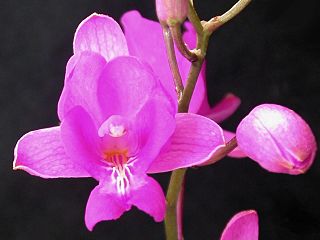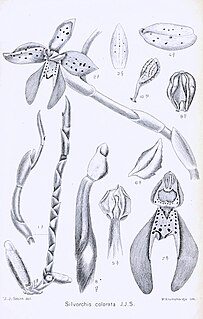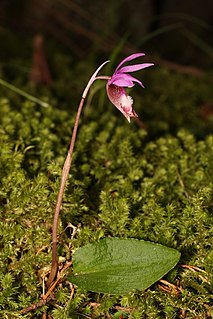The taxonomy of the Orchidaceae has evolved slowly during the last 250 years, starting with Carl Linnaeus who in 1753 recognized eight genera. De Jussieu recognized the Orchidaceae as a separate family in his Genera Plantarum in 1789. Olof Swartz recognized 25 genera in 1800. Louis Claude Richard provided us in 1817 with the descriptive terminology of the orchids.. The next step was taken in 1830-1840 by John Lindley, who recognized four subfamilies. He is generally recognized as the father of orchid taxonomy. The next important step was taken by George Bentham with a new classification, recognizing subtribes for the first time. This classification was first presented in a paper that Bentham read to the Royal Society in 1881. Then it was published in 1883 in the final volume of Genera Plantarum. The next great contributors were Pfitzer (1887), Schlechter (1926), Mansfeld (1937), Dressler and Dodson (1960), Garay, Vermeulen (1966), again Dressler (1981). and Burns-Balogh and Funk (1986). Dressler's 1993 book had considerable influence on later work.

Vanilloideae is one of the subfamilies of orchids belonging to the large family Orchidaceae.

Coelia is a genus of orchids. It had previously been tentatively classified as the only genus of the subtribe Coeliinae of the tribe Epidendreae.

Laeliinae is a Neotropical subtribe including 40 orchid genera, such as Brassavola, Laelia and Cattleya. The genus Epidendrum is the largest within this subtribe, containing about 1500 species. This is followed by the genus Encyclia, with over 120 species.

Pogoniopsis is a genus of orchids. It contains two known species, both endemic to Brazil. It was previously included in the subfamily Vanilloideae, but is now placed in the tribe Triphoreae of the subfamily Epidendroideae.

Bletiinae is a small-sized subtribe of orchids in the tribe Epidendreae of the subfamily Epidendroideae.
Ponerinae is a subtribe of the Orchidaceae tribe Epidendreae. The Ponerinae are characterized by sympodial stems that do not form pseudobulbs, bear two or more leaves, and a racemose or paniculate inflorescence carrying flowers with four or six pollinia.

The tribe Epidendreae of the Orchidaceae comprises six subtribes:
Vargasiella is a genus of flowering plants from the orchid family, Orchidaceae. It contains two species, both endemic to South America: It has been treated as the only genus in the subtribe Vargasiellinae, but more recently has been included in the subtribe Zygopetalinae.
Risleya is a monotypic genus of flowering plants from the orchid family, Orchidaceae. The sole species is Risleya atropurpurea. It is native to the Himalayas of Sichuan, Tibet, Yunnan, Bhutan, India, Sikkim, Assam and Myanmar. It was previously included in the subtribe Malaxidinae but is now placed in the tribe Collabieae.

Silvorchis is a genus of flowering plants from the orchid family, Orchidaceae. Only one species is known, Silvorchis colorata, endemic to Java. This is a holomycotrophic species, completely lacking in chlorophyll.

The Eriinae form a subtribe of Podochileae, a tribe of the orchid family (Orchidaceae). The name is derived from the genus Eria.

Dendrobieae is a tribe in the subfamily Epidendroideae, in the family Orchidaceae.

Diseae is an orchid tribe in the subfamily Orchidoideae. It was recognized in Genera Orchidacearum volume 2, which was published in 2001. It consisted of 12 genera in five subtribes. In molecular phylogenetic studies that were published after 1999, it was shown that Diseae is paraphyletic over the tribe Orchideae. In a classification of orchids that was published in 2015, Diseae was not recognized, but was instead placed in synonymy under Orchideae.

The Coelogyninae are an orchid subtribe in the tribe Arethuseae.

Calypsoinae is an orchid subtribe in the tribe Epidendreae of subfamily Epidendroideae. It has previously been recognized as tribe Calypsoeae in the subfamily Epidendroideae.

Gastrodieae is an orchid tribe in the subfamily Epidendroideae.

Malaxideae is an orchid tribe in the subfamily Epidendroideae.

Malaxidinae is an subtribe of orchids in the tribe Malaxideae of the subfamily Epidendroideae.

Neottieae is an orchid tribe in the subfamily Epidendroideae. It contains six genera and over 200 species distributed mainly in temperate and subtropical zones of the northern hemisphere. All its members are terrestrial plants, hinting at an early branching with Epidendroideae which is largely an epiphytic group. Neottieae is likely to be the result of a single temperate radiation of epidendroids, although it appears that some lineages in this tribe have crept back into the tropics.














